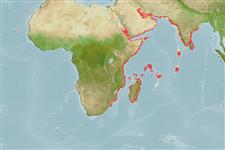>
Eupercaria/misc (Various families in series Eupercaria) >
Nemipteridae (Threadfin breams, Whiptail breams)
Etymology: Scolopsis: Name from the Greek masculine noun 'skolos' meaning 'thorn' and suffix '-opsis' (from Greek feminine n. 'opsis' meaning 'aspect', 'appearance') meaning ‘thorny appearance’ presumably referring to 'les dentelures de la préopercule, en ont aussi, et même d'épineuses, aux sous-orbitaires' mentioned by Cuvier (1814) in his designation of the genus. Name ending in -'opsis' are treated as feminine according to ICZN 1999: Article 30.1.2 (Ref. 130620).
More on author: Rüppell.
Environment: milieu / climate zone / depth range / distribution range
Ecologia
marino associati a barriera corallina; distribuzione batimetrica ? - 60 m (Ref. 9710). Tropical; 31°N - 29°S, 32°E - 85°E (Ref. 3810)
Indian Ocean: Red Sea, Persian Gulf and from Muscat, Oman to Delagoa Bay, Mozambique. Also from Madagascar, Sri Lanka and the Bay of Bengal.
Size / Peso / Age
Maturity: Lm ? range ? - ? cm
Max length : 31.0 cm TL maschio/sesso non determinato; (Ref. 9710); common length : 13.0 cm SL maschio/sesso non determinato; (Ref. 3810)
Spine dorsali (totale) : 10; Raggi dorsali molli (totale) : 9; Spine anali: 3; Raggi anali molli: 7. Head scales reaching forward to level of posterior nostrils. Lower limb of preopercle scaly. Antrorse (forward-directed) suborbital spine absent. Pelvic fins long, reaching to between level of anus and origin of anal fin. Axillary scale present. Color: Upper body grey, whitish below. A blue stripe joining eyes.
Found in inshore waters usually on coral reefs or sand or mud bottoms close to reefs (Ref. 30573). Feeds on crustaceans, mollusks, echinoderms and fishes (Ref. 30573).
Life cycle and mating behavior
Maturities | Riproduzione | Spawnings | Egg(s) | Fecundities | Larve
Russell, B.C., 1990. FAO Species Catalogue. Vol. 12. Nemipterid fishes of the world. (Threadfin breams, whiptail breams, monocle breams, dwarf monocle breams, and coral breams). Family Nemipteridae. An annotated and illustrated catalogue of nemipterid species known to date. FAO Fish. Synop. 125(12):149p. Rome: FAO. (Ref. 3810)
IUCN Red List Status (Ref. 130435)
Threat to humans
Harmless
Human uses
Pesca: scarso interesse commerciale
Strumenti
Special reports
Download XML
Fonti Internet
Estimates based on models
Preferred temperature (Ref.
123201): 24.6 - 29.2, mean 27.2 °C (based on 326 cells).
Phylogenetic diversity index (Ref.
82804): PD
50 = 0.5000 [Uniqueness, from 0.5 = low to 2.0 = high].
Bayesian length-weight: a=0.01202 (0.00657 - 0.02201), b=2.95 (2.80 - 3.10), in cm total length, based on LWR estimates for this species & Genus-body shape (Ref.
93245).
Trophic level (Ref.
69278): 3.8 ±0.56 se; based on food items.
Resilienza (Ref.
120179): Alto, tempo minimo di raddoppiamento della popolazione meno di 15 mesi (Preliminary K or Fecundity.).
Fishing Vulnerability (Ref.
59153): Low vulnerability (21 of 100).
Nutrients (Ref.
124155): Calcium = 51.7 [31.5, 101.8] mg/100g; Iron = 0.624 [0.303, 1.554] mg/100g; Protein = 19.1 [17.3, 20.8] %; Omega3 = 0.157 [0.095, 0.262] g/100g; Selenium = 31.1 [18.6, 55.6] μg/100g; VitaminA = 75.4 [21.9, 216.5] μg/100g; Zinc = 1.15 [0.80, 1.64] mg/100g (wet weight);
